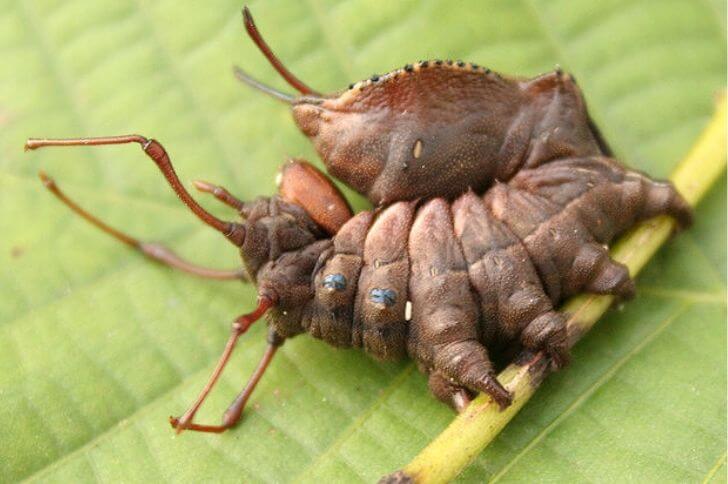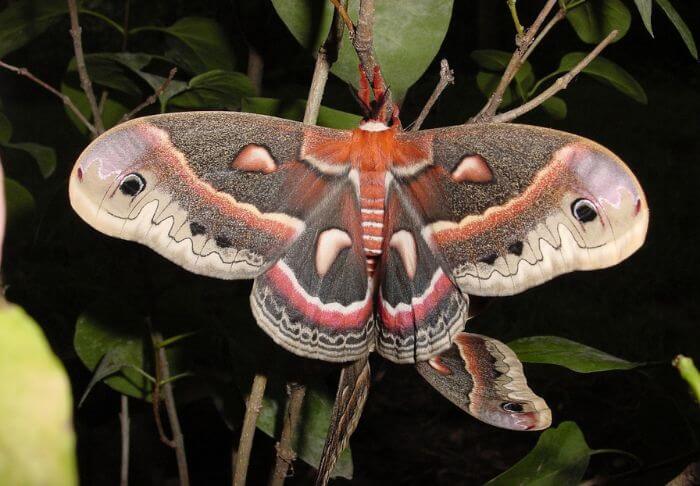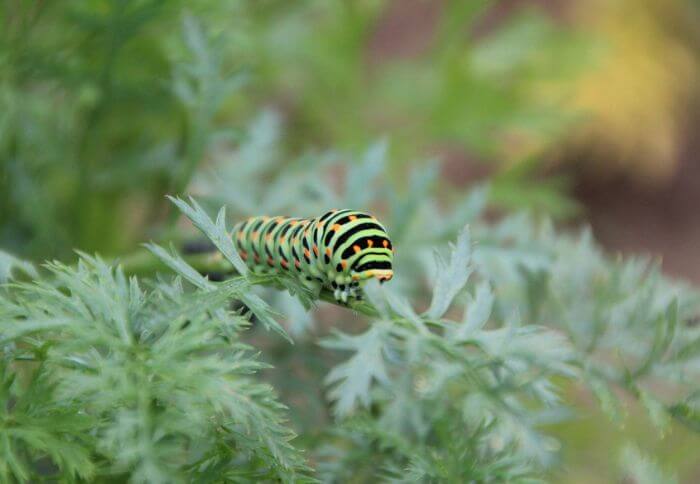10 Caterpillars with Big Heads (Identification)
Have you ever wondered why some caterpillars have heads that seem disproportionately large compared to their tiny bodies? It’s like they’re wearing a bulbous hat that’s ready to burst! Well let me introduce you to the fascinating world of caterpillars with large heads.
These peculiar creatures not only defy the norms of insect anatomy but also hold secrets that may leave you in awe. From bizarre defense mechanisms to extraordinary adaptability, get ready to delve into the captivating lives these creatures lead.
List of Caterpillars with Big Heads
1. Eastern Tiger Swallowtail Caterpillar
The Eastern Tiger Swallowtail Caterpillar is truly a fascinating creature to behold. With its vibrant green body and striking black stripes, it stands out among the many caterpillar species found in North America. But what sets this caterpillar apart from the rest is its large head.
Unlike other caterpillars with smaller heads, the Eastern Tiger Swallowtail Caterpillar’s oversized cranium serves a vital purpose. This unique adaptation allows it to consume an abundance of leaves, aiding in its rapid growth and development.
The large head also provides an advantage when it comes to defending against predators, as its intimidating appearance can deter would-be attackers.
Additionally, the enlarged head plays a critical role during metamorphosis. As the caterpillar prepares to transform into a pupa, it must shed its old skin one final time before entering the chrysalis stage.
The large head helps facilitate this process by allowing space for both the old skin and new growing skin beneath. It’s yet another remarkable example of how nature has equipped these creatures with everything they need for their respective life stages.
2. Red Helen Swallowtail Caterpillar
The Red Helen Swallowtail Caterpillar is a striking insect with its vibrant hues of red and black. Its large head is undoubtedly one of the prominent features that make it stand out among other caterpillars.
This species belongs to the Papilionidae family, which includes some of the most stunning butterflies in the world.
The size of the Red Helen Swallowtail Caterpillar’s head serves important purposes during its growth and development. Firstly, it houses powerful mandibles that aid in consuming leaves from their preferred host plants, such as citrus trees.
The caterpillar relies on these nutrient-rich plants to fuel its rapid growth and eventual transformation into a magnificent butterfly. Secondly, this caterpillar’s distinctive head helps it defend against potential predators by showcasing its aposematic coloration; colors that signal danger or toxicity.
3. Elephant Hawk-Moth Caterpillar
The Elephant Hawk-Moth Caterpillar is a fascinating creature known for its striking appearance. With a large, bulbous head that resembles an elephant’s trunk, it certainly stands out among its counterparts. However, this unique feature serves more than just an aesthetic purpose.
One interesting fact about the Elephant Hawk-Moth Caterpillar’s large head is that it contains special scent organs called osmeteria.
When threatened or disturbed, the caterpillar retracts its head and exposes these orange-colored organs which release a foul-smelling odor to deter predators. This defense mechanism not only surprises attackers but also gives the caterpillar time to escape from danger.
Another intriguing aspect of the Elephant Hawk-Moth Caterpillar’s large head is its ability to mimic snake-like movements.
By elongating and contracting their bodies while moving their heads from side to side, these little creatures can convincingly imitate the intimidating motions of a snake. This clever strategy helps them scare away potential predators and increases their chances of survival in the wild.
Related Read: check white poisonous caterpillars
4. Spicebush Swallowtail Caterpillar
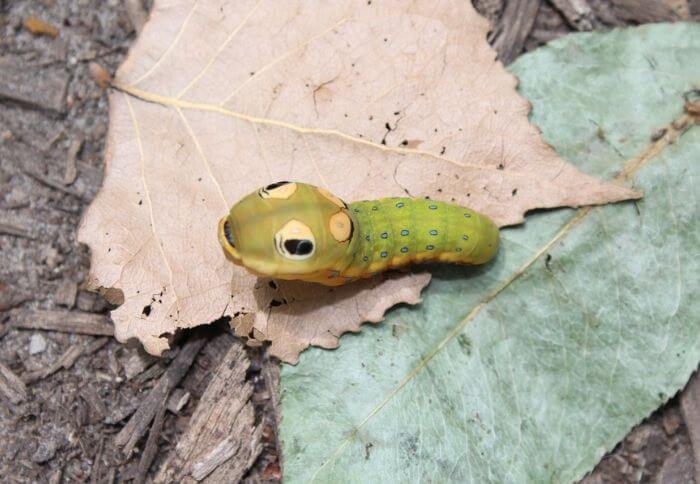
The Spicebush Swallowtail Caterpillar is a fascinating creature with its distinct markings and large, bulbous head. These caterpillars are commonly found in eastern North America, especially in wooded areas where spicebush plants grow abundantly.
Their vibrant green bodies serve as excellent camouflage among the leaves, but it’s their oversized heads that truly capture attention.
Despite their somewhat disproportionate appearance, the enlarged head of the Spicebush Swallowtail Caterpillar serves a crucial purpose. It houses powerful jaws that allow them to consume their primary food source: spicebush leaves.
By having such a robust head, these caterpillars can efficiently strip the plant leaves and devour them without much effort. This evolutionary adaptation not only ensures their survival but also plays an essential role in maintaining the delicate balance of ecosystems they inhabit.
5. Hemeroplanes Triptolemus
Hemeroplanes triptolemus, also known as the common clearwing, is a fascinating caterpillar species that stands out due to its unusually large head.
This distinctive feature not only adds to its aesthetic appeal but also serves an important purpose. The enlarged head acts as a deterrent against predators, creating the illusion of a formidable creature capable of protecting itself.
When threatened, the Hemeroplanes triptolemus will vigorously swing its elongated head back and forth, which can startle potential attackers and give it time to escape.
This large-headed caterpillar’s unique defense mechanism is not just for show; it is also highly effective. By mimicking snakes or other dangerous organisms in appearance and behavior, Hemeroplanes triptolemus has mastered the art of deception in order to survive.
It’s amazing how nature equips these vulnerable creatures with such astonishing adaptation strategies to ensure their survival in harsh environments.
The sheer creativity displayed by this little-known species serves as a reminder that there is always something new and captivating waiting to be discovered within the natural world surrounding us.
6. Tersa Sphinx Moth Caterpillar
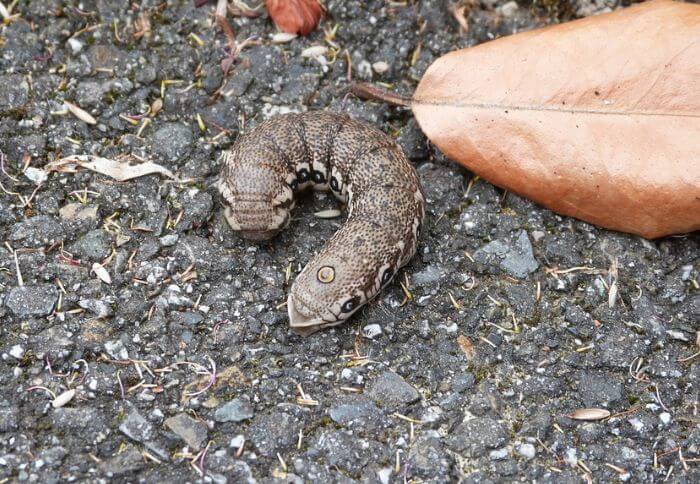
The Tersa Sphinx Moth Caterpillar is a fascinating creature with a distinct feature that sets it apart from other caterpillars – its large head.
This unique characteristic not only gives the caterpillar a striking appearance, but also serves a practical purpose. The large head of the Tersa Sphinx Moth Caterpillar houses powerful mandibles that allow it to devour leaves and plants with incredible efficiency.
Despite its somewhat intimidating appearance, the Tersa Sphinx Moth Caterpillar is harmless to humans. In fact, it plays an important role in our ecosystem as a pollinator.
When it undergoes metamorphosis and transforms into an adult moth, it becomes equipped with long proboscis used for feeding on flower nectar. As it flutters from one blossom to another, unknowingly transferring pollen along the way, it contributes to the cross-pollination of various plant species.
7. Phyllodes Imperialis (Pink Underwing Moth)
One of the most intriguing caterpillars with a large head is the Phyllodes imperialis, also known as the Pink Underwing Moth. This stunning creature boasts vibrant shades of pink and green, forming an exquisite color combination that immediately catches the eye.
The distinct characteristic that sets this caterpillar apart from others is its disproportionately large head, which not only adds to its allure but also serves a vital purpose in its survival.
The sheer size of the Phyllodes imperialis’s head may seem out of proportion at first glance, but it has evolved for a specific reason: protection. When threatened by predators or disturbed by external factors, this caterpillar uses its oversized head as a defensive mechanism.
By contorting and arching their bodies while displaying their enormous heads, they create a striking illusion that scares off potential threats such as birds or reptiles. This impressive adaptation allows them to defend themselves effectively while remaining masters of deception in their natural environment.
In addition to being visually stunning and possessing an exceptional defense mechanism, Phyllodes imperialis caterpillars also exhibit fascinating feeding habits. Rather than feasting on plant leaves like many other species do, they have become specialized feeders on ferns.
These unique dietary preferences have contributed to their thriving existence in various regions around the world where ferns are abundant. Moreover, this specialization showcases how organisms can adapt and evolve to be highly efficient in obtaining nutrients from specific food sources.
8. Nolid Moth Caterpillar
The Nolid Moth Caterpillar may be small in size, but it certainly makes up for it with its large head. This peculiar feature sets it apart from other caterpillars and catches the eye instantly.
The oversized head of the Nolid Moth Caterpillar serves a unique purpose – defense. When threatened, this ingenious creature can retract its head into its body, hiding it completely from view and leaving only a fake head on its tail end.
This incredible adaptation is believed to confuse predators and provide the caterpillar with an escape route.
What’s even more fascinating about the Nolid Moth Caterpillar is that these distinctive heads come in varied colors and patterns. Some have bright yellow heads with contrasting dark eyespots, while others boast vibrant green or red heads that are adorned with intricate markings.
This remarkable diversity not only adds to their captivating appearance but also emphasizes their effectiveness as a defense mechanism. By showcasing such bold colors, they signal their unpalatability to potential predators.
9. Death’s-head Hawkmoth Caterpillar
The death’s-head hawkmoth caterpillar, with its distinct skull-like markings on its head, is a truly fascinating creature. This unusual appearance has earned it a reputation as an omen of death in folklore and popular culture. But there is much more to this caterpillar than meets the eye.
One unique feature of the death’s-head hawkmoth caterpillar is its ability to emit a loud squeaking sound when disturbed. This serves as a defense mechanism, frightening away potential predators. It’s almost as if this tiny creature is warning others to stay away or face the consequences.
Another intriguing aspect of this caterpillar is its diet preference for potato plants and tomatoes, making it a common pest in agricultural areas. While this may be frustrating for farmers, it highlights the adaptability and resourcefulness of these creatures.
10. Silver-spotted Skipper Caterpillar
One caterpillar that stands out amongst the rest with its unique appearance is the silver spotted skipper caterpillar. With a large head and striking markings, this caterpillar has a distinct allure that captures the attention of anyone lucky enough to spot it. Its black body is dotted with small silver spots, giving it an almost magical quality.
But what truly sets this caterpillar apart is its behavior. Unlike other caterpillars, which tend to move in a slow and deliberate manner, the silver spotted skipper caterpillar is surprisingly quick and nimble.
It can dart from leaf to leaf with lightning speed, making it difficult to keep up with and observe closely. This swift movement may serve as a defense mechanism against predators or simply be an adaptation for efficiently gathering food.
Final Thoughts:
Caterpillars with large heads come in a variety of species and have unique characteristics that set them apart from other caterpillar types. From the striking Manduca sexta with its oversized mandibles to the fascinating horned caterpillar of the Hemileuca genus, these creatures showcase the incredible diversity found in nature.
Understanding the different types of caterpillars with large heads can provide valuable insights into their behavior, feeding habits, and ecological roles.
Whether you are a nature enthusiast or a scientist studying entomology, exploring the world of these captivating insects can be an exciting and rewarding experience.
So next time you spot a caterpillar with a disproportionately large head, take a closer look and marvel at the wonders of evolution and adaptation.
source:
Eastern swallowtail caterpillar

Passionate animal enthusiast and skilled writer with a flair for captivating storytelling. With over five years of experience, I have crafted engaging content that sheds light on the fascinating world of animals.
Through my articles, blog posts, and social media campaigns, I strive to raise awareness about conservation efforts and promote a deeper understanding of the natural world.

